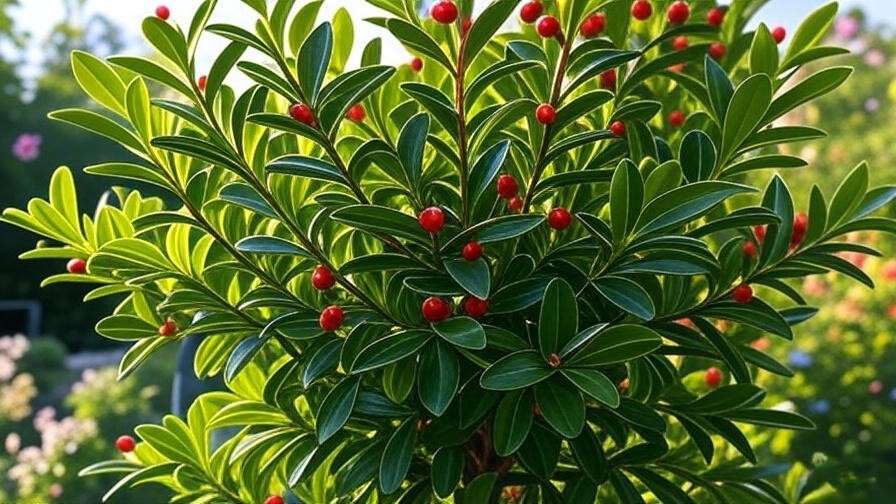Imagine a garden that stays vibrant year-round, with glossy evergreen leaves and bursts of red berries that attract cheerful birds even in the depths of winter. The Savannah Holly Tree (Ilex x attenuata ‘Savannah’) can make this vision a reality. This stunning hybrid holly is a favorite among gardeners for its low-maintenance charm and striking beauty, perfect for hedges, privacy screens, or standalone elegance. Whether you’re a novice gardener or a seasoned landscaper, this comprehensive guide will empower you to grow and care for a thriving Savannah Holly Tree. As a horticulturist with over 15 years of experience in tree care and landscape design, I’ve cultivated countless hollies and am excited to share expert insights to ensure your tree flourishes. From planting tips to seasonal care, let’s dive into everything you need to make your Savannah Holly the star of your garden! 🌟
1. Understanding the Savannah Holly Tree 🌳
1.1 What Is a Savannah Holly Tree? 🌟
The Savannah Holly Tree, scientifically known as Ilex x attenuata ‘Savannah’, is a hybrid of American and Dahoon hollies, celebrated for its ornamental appeal. This evergreen tree boasts glossy, dark green leaves with soft, serrated edges and produces vibrant red berries in fall and winter, adding seasonal flair. Growing 15–20 feet tall and 8–12 feet wide, it’s a medium-sized tree ideal for various garden settings. Its moderate growth rate (1–2 feet per year) makes it manageable for homeowners seeking beauty without overwhelming upkeep.
1.2 Why Choose a Savannah Holly Tree? 😊
The Savannah Holly is a gardener’s dream for several reasons:
- Aesthetic Appeal: Its lush foliage and bright berries create a year-round focal point, perfect for formal or natural landscapes.
- Wildlife Benefits: The berries attract birds like cardinals and robins, while pollinators love its small spring flowers.
- Low Maintenance: Once established, it’s drought-tolerant and adaptable to various soil types, making it ideal for busy gardeners.
Compared to other hollies, the Savannah Holly stands out for its softer leaves (less prickly than American holly) and prolific berry production, enhancing its decorative value.
1.3 Ideal Growing Zones and Conditions ☀️
Savannah Holly thrives in USDA Hardiness Zones 6–9, covering much of the U.S., from the Southeast to parts of the Midwest and West Coast. It prefers full sun to partial shade, requiring at least 4–6 hours of direct sunlight daily for optimal growth and berry production. Well-drained, slightly acidic soil (pH 5.5–6.5) is ideal, though it tolerates clay or sandy soils with proper amendments. Unlike some hollies, it’s moderately drought-tolerant but benefits from consistent moisture in hotter climates.
2. Planting Your Savannah Holly Tree 🌱
2.1 When and Where to Plant 🕒
Timing and location are critical for a healthy Savannah Holly. The best planting seasons are spring or early fall, allowing roots to establish before extreme heat or cold. Choose a spot with:
- Sunlight: Full sun to partial shade for vibrant growth.
- Space: Allow 8–12 feet of width to accommodate its mature spread.
- Drainage: Avoid low-lying areas where water pools, as hollies dislike soggy roots.
Consider proximity to pollinators, as female trees need a male holly nearby (within 50 feet) for berry production.
2.2 Step-by-Step Planting Guide 🌍
Follow these steps for successful planting:
- Test Soil: Use a soil test kit to ensure a pH of 5.5–6.5. Amend with sulfur if too alkaline or lime if too acidic.
- Prepare the Site: Clear weeds and add organic compost to enrich the soil.
- Dig the Hole: Make it twice as wide and as deep as the root ball (e.g., 24 inches wide for a 12-inch root ball).
- Plant the Tree: Place the tree so the root crown is level with the soil surface. Backfill with a mix of native soil and compost.
- Water and Mulch: Water thoroughly and apply 2–3 inches of organic mulch (pine bark or wood chips) around the base, keeping it 2 inches from the trunk.
- Stake if Needed: Use stakes for young trees in windy areas to prevent leaning.
Expert Tip: Water deeply once a week for the first year to encourage strong roots.
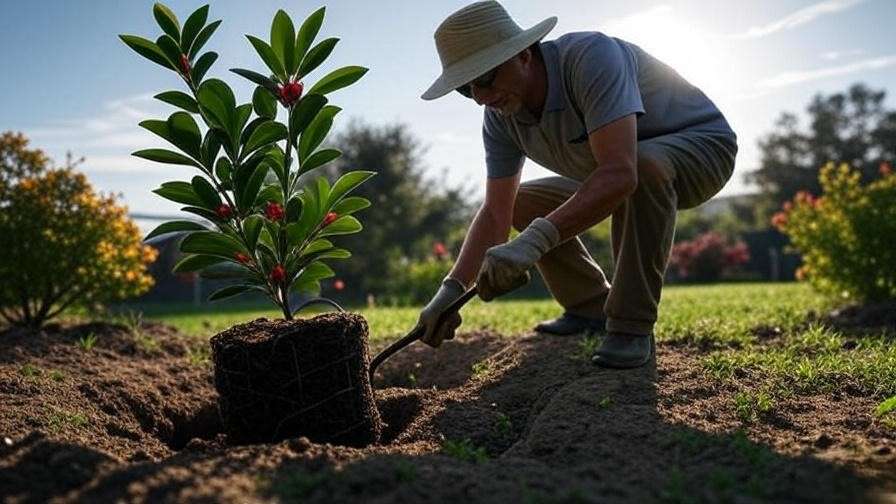
2.3 Common Planting Mistakes to Avoid 🚫
Avoid these pitfalls to ensure your Savannah Holly thrives:
- Overwatering: Soggy soil leads to root rot. Check soil moisture before watering.
- Planting Too Deep: Burying the root crown can suffocate the tree.
- Wrong Location: Too much shade reduces berry production and weakens growth.
Case Study: A Georgia homeowner planted their Savannah Holly in a shady, waterlogged corner, resulting in yellowing leaves. After relocating it to a sunnier, well-drained spot and adjusting soil pH, the tree flourished within a season.
3. Essential Care Tips for a Healthy Savannah Holly Tree 🌿
3.1 Watering Needs 💧
Proper watering is key, especially during the first two years:
- Newly Planted Trees: Water 1–2 times per week, providing 1–2 gallons per session, depending on rainfall.
- Established Trees: Water every 10–14 days during dry spells, ensuring deep soil penetration.
- Signs of Trouble: Yellowing leaves may indicate overwatering, while wilting suggests underwatering.
Expert Insight: Use a soaker hose to deliver water slowly, preventing runoff and ensuring roots absorb moisture effectively.
3.2 Fertilizing for Optimal Growth 🌼
Fertilize to support healthy foliage and berries:
- Type: Use a slow-release, acid-loving fertilizer (e.g., 10-10-10 or holly-specific formulas).
- Timing: Apply in early spring and late summer, following package instructions (typically 1 pound per 100 square feet).
- Caution: Over-fertilizing can cause leaf burn or excessive vegetative growth at the expense of berries.
Test soil annually to monitor nutrient levels and adjust as needed.
3.3 Pruning and Shaping ✂️
Pruning keeps your Savannah Holly tidy and healthy:
- When: Prune in late winter or early spring before new growth begins.
- How: Remove dead, damaged, or crossing branches. Shape lightly to maintain natural form or create a formal hedge.
- Tools: Use clean, sharp bypass pruners for precise cuts.
- Berry Boost: Light pruning encourages air circulation, enhancing flower and berry production.
Example: A well-pruned Savannah Holly hedge in a Virginia garden maintained a lush, uniform shape, boosting curb appeal.
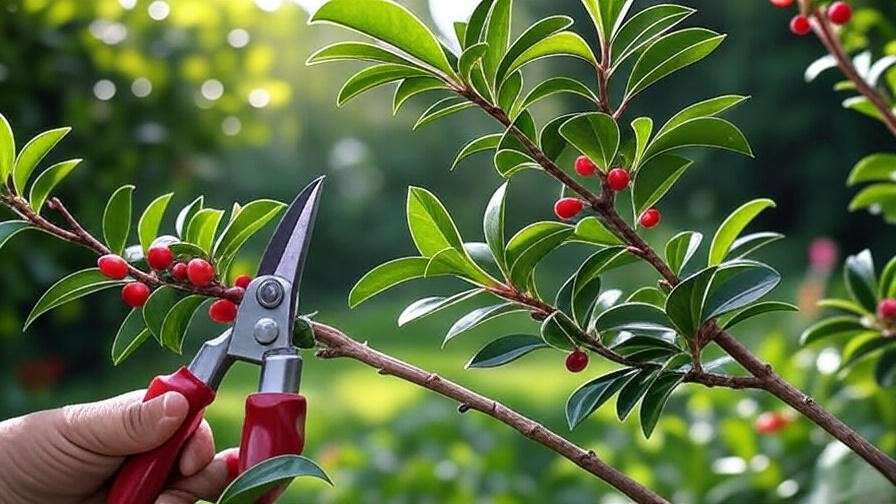
3.4 Mulching and Soil Care 🌱
Mulch is a game-changer for holly health:
- Benefits: Retains moisture, suppresses weeds, and regulates soil temperature.
- Materials: Use pine bark, wood chips, or shredded leaves (2–3 inches thick).
- Application: Spread mulch in a 3-foot radius around the tree, avoiding direct contact with the trunk to prevent rot.
Refresh mulch annually to maintain benefits.
4. Addressing Common Problems and Pests 🐞
4.1 Identifying and Managing Pests 🕷️
While Savannah Holly Trees are relatively pest-resistant, they can occasionally attract unwanted visitors. Common pests include:
- Scale Insects: Small, immobile pests that suck sap, causing yellowing leaves. Look for tiny, waxy bumps on stems or leaves.
- Spider Mites: Microscopic pests that create fine webbing and stippled leaves, especially in hot, dry conditions.
- Leaf Miners: Larvae that tunnel through leaves, leaving visible trails.
- Organic: Spray neem oil or insecticidal soap for scale and mites. Encourage natural predators like ladybugs.
- Chemical: Use horticultural oil for severe infestations, following label instructions carefully.
- Prevention: Inspect leaves regularly, maintain tree vigor with proper care, and avoid overhead watering to reduce humidity.
Expert Tip: A strong blast of water can dislodge early-stage spider mites before they become a problem.

4.2 Dealing with Diseases 🦠
Savannah Hollies are generally hardy but may face fungal issues:
- Leaf Spot: Black or brown spots on leaves, often caused by excessive moisture. Remove affected leaves and improve air circulation.
- Root Rot: Caused by poorly drained soil, leading to wilting or yellowing. Ensure proper drainage and avoid overwatering.
- Treatment: Apply a copper-based fungicide for leaf spot, and for root rot, improve soil drainage or replant in a better location.
- Prevention: Space trees adequately, mulch properly, and avoid watering late in the day.
Pro Insight: Fungal diseases thrive in wet conditions—always water at the base, not the foliage, to keep leaves dry.
4.3 Environmental Stressors 🌪️
Environmental factors can stress your Savannah Holly, but they’re manageable:
- Drought: Prolonged dry spells cause leaf drop or browning. Water deeply during droughts (1–2 inches per week).
- Extreme Heat: High temperatures may scorch leaves. Provide afternoon shade in hotter climates or use temporary shade cloth.
- Cold Snaps: In Zone 6, protect young trees with burlap wraps during harsh winters.
- Signs of Stress: Yellowing leaves, stunted growth, or reduced berry production indicate environmental issues.
Case Study: A North Carolina gardener noticed their Savannah Holly dropping berries prematurely during a heatwave. By increasing irrigation and adding mulch, they restored the tree’s health within weeks.
5. Seasonal Care for Your Savannah Holly Tree 🍂
5.1 Spring and Summer Care 🌞
Spring and summer are growth seasons for your Savannah Holly:
- Watering: Ensure consistent moisture, especially during dry spells. Aim for 1 inch of water per week, adjusting for rainfall.
- Pollination: Female trees need a male pollinator nearby for berries. Plant a male holly (like ‘Foster’s No. 2’) within 50 feet if berries are sparse.
- Monitoring: Check for pests and prune lightly to shape or remove suckers.
- Heat Protection: In southern climates, provide afternoon shade to prevent leaf scorch.
5.2 Fall and Winter Care ❄️
As your tree enters dormancy, adjust care:
- Watering: Reduce to every 2–3 weeks unless the soil is very dry.
- Mulching: Add a fresh 2–3 inch layer of mulch to insulate roots against cold.
- Winter Protection: Wrap young trees in burlap in colder zones (6–7) to shield from wind and frost.
- Decorative Use: Harvest berries and foliage sustainably for holiday wreaths or garlands, cutting no more than 10% of branches.
Expert Tip: Avoid heavy pruning in fall to prevent stressing the tree before winter.
6. Landscaping Ideas with Savannah Holly Trees 🌸
6.1 Using Savannah Holly in Garden Design 🌳
The Savannah Holly’s versatility makes it a landscaping superstar:
- Hedges or Privacy Screens: Plant 5–6 feet apart for a dense, evergreen barrier.
- Specimen Tree: Use as a focal point in a lawn or near a patio for year-round beauty.
- Foundation Planting: Pair with low-growing shrubs like azaleas or boxwoods for a layered look.
- Companion Plants: Combine with camellias, ferns, or hostas for texture and color contrast.
Example: A South Carolina homeowner transformed their front yard with a Savannah Holly hedge, complemented by colorful annuals, creating a polished, welcoming entrance.
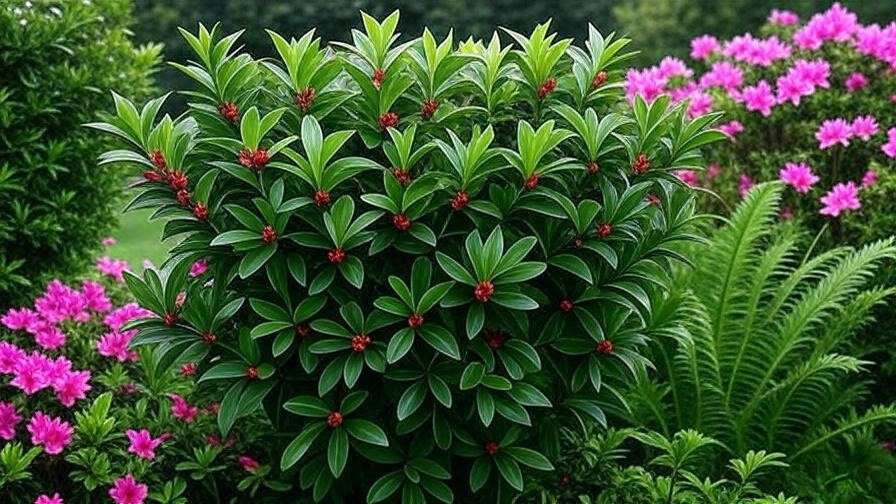
6.2 Creative Uses for Berries and Foliage 🎄
Savannah Holly’s berries and leaves shine in creative projects:
- Holiday Decor: Craft wreaths, garlands, or table centerpieces with berries and glossy leaves.
- Wildlife Gardens: Leave berries on the tree to feed birds like cedar waxwings during winter.
- Eco-Friendly Design: Use fallen leaves as natural mulch or compost material.
Inspiration: Photos of a Savannah Holly adorned with fairy lights for a festive winter garden glow can spark ideas for your own space.
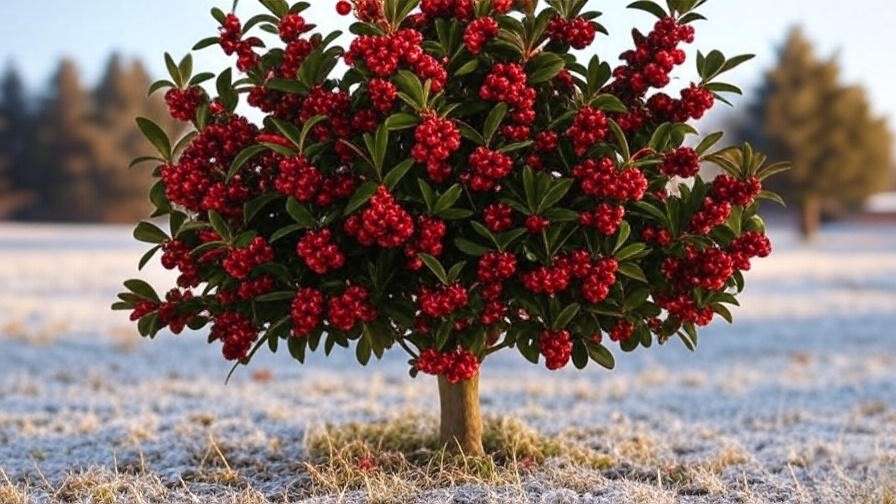
7. FAQs About Savannah Holly Tree Care ❓
Q: How fast does a Savannah Holly Tree grow?
A: It grows moderately at 1–2 feet per year under ideal conditions, reaching maturity in 8–10 years.
Q: Do I need both male and female trees for berries?
A: Yes, female trees require a male holly within 50 feet for pollination and berry production.
Q: Can Savannah Holly grow in containers?
A: Young trees can thrive in large containers (15+ gallons) for a few years, but they perform best in-ground for long-term growth.
Q: How do I prevent yellowing leaves?
A: Test soil pH (aim for 5.5–6.5), ensure proper drainage, and avoid overwatering or nutrient deficiencies.
Q: Is Savannah Holly deer-resistant?
A: Yes, its tough leaves deter deer, making it a great choice for deer-prone areas.
8. Expert Tips for Long-Term Success 🌟
- Soil Testing: Check pH annually and amend as needed to maintain 5.5–6.5 for optimal nutrient uptake.
- Organic Care: Use compost tea or fish emulsion for natural fertilization, reducing chemical use.
- Water Conservation: Install a drip irrigation system for efficient, targeted watering.
- Wildlife Support: Plant native flowers nearby to attract pollinators, boosting berry production.
Pro Tip: Rotate mulch types (e.g., pine bark one year, wood chips the next) to enrich soil diversity and prevent compaction.
Conclusion 🎉
The Savannah Holly Tree is more than just a plant—it’s a year-round masterpiece that elevates your garden with minimal effort. By following this guide’s expert advice on planting, watering, pruning, and seasonal care, you’ll ensure your holly thrives for decades, delighting you with its glossy leaves and vibrant berries. Whether you’re creating a privacy hedge, a wildlife haven, or a holiday centerpiece, the Savannah Holly delivers unmatched beauty and versatility. Start your journey today, and share your success stories in the comments below! For more plant care tips, explore our guides on holly varieties and garden design. Transform your landscape with the timeless charm of a Savannah Holly Tree—your garden deserves this evergreen star! 🌿

